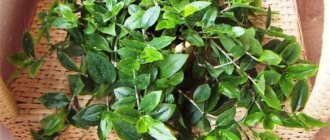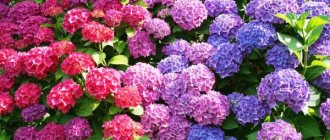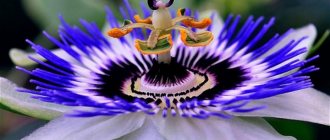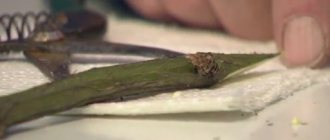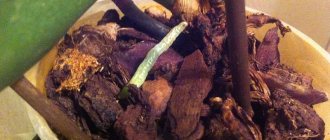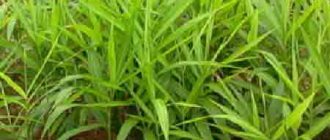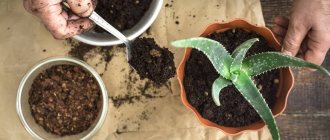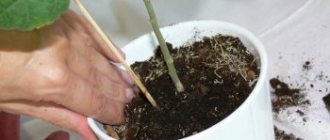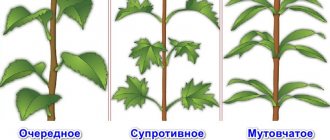Roots
Root vegetables are distinguished by the presence of a large amount of storage tissue. They usually form in biennial plants in the first year of life. In the second year, flowers, fruits, and seeds are formed. Thus, the root crop allows the plant to endure a period of dormancy and complete development the following year.
Root vegetable is a conditional name. It has nothing to do with fruits, since it is formed not from a flower, but from vegetative organs - stem and root.
The ratio of stem and root during the formation of root crops is different, for example, in carrots almost the entire root crop is formed by the root, and in turnips by the stem.
Modern root vegetables are artificially bred by humans. They play an important role in its nutrition, as well as in feeding animals.
Content
The list includes indoor plants
- plants introduced into cultivation as ornamental ones, suitable for growing in homes and landscaping interiors [1] [2].
Houseplants, according to their decorative properties, are usually divided into three broad groups. Plants from the first two are decorative leafy indoor plants
and
decorative flowering indoor plants
- do not lose their decorative value throughout the year.
The third group - decorative flowering potted plants
- is seasonal, represented by plants that are attractive only during the flowering period [1] [3].
In addition, among indoor plants there are separate groups of orchids, bromeliads, cacti
and
succulent plants, palms, ferns, bulbous plants,
as well as
fruiting plants
. This division is dictated both by the special decorative qualities of these plants, due to their appearance, and by the specific requirements for living conditions in each of the groups [1] [3].
Root cones
If the root crop is a thickened main root, then the root cones are strongly thickened adventitious and lateral roots. They, like root crops, are characterized by a developed storage parenchyma. Root cones form adventitious buds, therefore they are organs of vegetative propagation. Dahlia, sweet potato, and chistyak have these types of roots.
TOP 4 articles
who are reading along with this
Root
Root zones
Modifications of shoots
Leaf modification
External structure of the root. Internal structure of the root
Root zones
Root cap
The root grows in length from its apex, where the young cells of the educational tissue are located. The growing part is covered with a root cap, which protects the root tip from damage and facilitates the movement of the root in the soil during growth. The latter function is carried out due to the property of the outer walls of the root cap being covered with mucus, which reduces friction between the root and soil particles. They can even push soil particles apart. The cells of the root cap are living and often contain starch grains. The cells of the cap are constantly renewed due to division. Participates in positive geotropic reactions (direction of root growth towards the center of the Earth).
The cells of the division zone are actively dividing; the extent of this zone varies in different species and in different roots of the same plant.
Behind the division zone is an extension zone (growth zone). The length of this zone does not exceed a few millimeters.
As linear growth completes, the third stage of root formation begins—its differentiation; a zone of cell differentiation and specialization (or a zone of root hairs and absorption) is formed. In this zone, the outer layer of the epiblema (rhizoderm) with root hairs, the layer of the primary cortex and the central cylinder are already distinguished.
Root hair structure
Root hairs are highly elongated outgrowths of the outer cells covering the root. The number of root hairs is very large (per 1 mm2 from 200 to 300 hairs). Their length reaches 10 mm. Hairs form very quickly (in young apple tree seedlings in 30-40 hours). Root hairs are short-lived. They die off after 10-20 days, and new ones grow on the young part of the root. This ensures the development of new soil horizons by the roots. The root continuously grows, forming more and more new areas of root hairs. Hairs can not only absorb ready-made solutions of substances, but also contribute to the dissolution of certain soil substances and then absorb them. The area of the root where the root hairs have died is able to absorb water for a while, but then becomes covered with a plug and loses this ability.
The hair shell is very thin, which facilitates the absorption of nutrients. Almost the entire hair cell is occupied by a vacuole, surrounded by a thin layer of cytoplasm. The nucleus is at the top of the cell. A mucous sheath is formed around the cell, which promotes the gluing of root hairs to soil particles, which improves their contact and increases the hydrophilicity of the system. Absorption is facilitated by the secretion of acids (carbonic, malic, citric) by root hairs, which dissolve mineral salts.
Root hairs also play a mechanical role - they serve as support for the root tip, which passes between the soil particles.
Under a microscope, a cross section of the root in the absorption zone shows its structure at the cellular and tissue levels. On the surface of the root there is rhizoderm, under it there is bark. The outer layer of the cortex is the exodermis, inward from it is the main parenchyma. Its thin-walled living cells perform a storage function, conducting nutrient solutions in a radial direction - from the suction tissue to the vessels of the wood. They also contain the synthesis of a number of organic substances vital for the plant. The inner layer of the cortex is the endoderm. Nutrient solutions entering the central cylinder from the cortex through endodermal cells pass only through the protoplast of cells.
The bark surrounds the central cylinder of the root. It borders on a layer of cells that retain the ability to divide for a long time. This is a pericycle. Pericycle cells give rise to lateral roots, adventitious buds and secondary educational tissues. Inward from the pericycle, in the center of the root, there are conductive tissues: bast and wood. Together they form a radial conductive bundle.
The root vascular system conducts water and minerals from the root to the stem (upward current) and organic matter from the stem to the root (downward current). It consists of vascular-fibrous bundles. The main components of the bundle are sections of phloem (through which substances move to the root) and xylem (through which substances move from the root). The main conducting elements of phloem are sieve tubes, xylem is trachea (vessels) and tracheids.
Breathing roots
This type of modified root is also found in the tropics. It is characteristic of trees growing on marshy ocean coasts. The root system of such plants is complex and has air-bearing tissue, aerenchyma. Through the holes, air enters the aerenchyma and then passes to remote underwater areas of the plant. Similar modifications occur in some ferns and red mangrove trees.
Rice. 2. Respiratory roots.
Yucca
In its homeland, North America, yucca grows in arid regions. Therefore, additional moisture from the air is vital for it.
Aerial roots deliver water to the plant. In addition, they perform the function of reproduction. You can get a young specimen of yucca vegetatively at home.
To do this, the top of the plant with aerial roots is transferred to a new pot, which should not be too large. In a significant amount of substrate, yucca will grow its root system for a long time. Only then will its green mass begin to increase in volume.
Columnar roots
The peculiarity of columnar roots is that they are laid on the branches. Such shoot roots are typical for the banyan tree.
Banyan is not the name of the plant. This is the name for the growth habit of some ficus plants. Any tree with a voluminous crown, supported by columnar roots, can be called a banyan.
Rice. 3. Indian banyan tree.
Dieffenbachia
The ideal temperature for growing Dieffenbachia is considered to be +25 degrees. The air humidity in the room should be about 60%. If this indicator decreases, the plant's aerial roots may dry out.
Shoots with aerial roots are often used for propagation. They are transplanted into a mixture of peat with leaf and turf soil. You can temporarily cover the plantings with film to create a greenhouse effect.
Water Dieffenbachia twice a week. Sometimes a complex fertilizer should be used. It is better to perform all procedures with gloves: the culture is quite poisonous.
Table “Modifications of roots”
| Types of roots | Examples of plants | Function |
| Roots | Turnips, radishes | storing |
| Root cones | Dahlia, Lyubka | storing |
| Respiratory | Avicennia | Supplying air to underwater areas of the plant |
| Stilates | Rhizophora | Increasing the support area |
| Columnar | Ficus | Increasing the support area |
Ficus
At home, the most commonly bred are Ficus rubber, Ficus lyre-shaped and Ficus Benjamin. With good care, the plants feel great and even bear fruit, similar to figs.
Beginning flower growers are often concerned with the question of what the small protrusions on the ficus trunk mean. These are actually aerial roots. In this way, the ornamental crop reacts to increased air humidity.
Sometimes such shoots emerge directly from the soil. They should not be removed, since the aerial root has an additional function - to receive and transmit oxygen to other cells.
Absorption of water and minerals by roots
Absorption of water and minerals by roots
Absorption of nutrients by the root occurs in active and passive ways. Active is associated with metabolic processes, energy expenditure, and breathing processes. The second, passive, is associated with the diffusion of substances. It does not depend on metabolic processes.
Through the root hairs, water and minerals enter through the passage cells into the vessels of the central cylinder. The place where the root enters the stem, that is, the root vessels in the stem, is called root collar . It is somewhat thickened. Hydrostatic pressure is formed due to the entry of water into the vessel from the parenchyma cells that surround them. This pressure is called root pressure . The ability of the root system to move water up the stem is called lower root motor . The ascending current from the root to the above-ground part of the plant is explained by the presence of root pressure and the suction action of the leaves due to transpiration (evaporation of water by the leaves).
The magnitude of turgor pressure in all parts of the plant is the same. Turgor (from Latin turgor - swelling, filling) is a tense state of the cell membrane, which arises due to the hydrostatic pressure of the cell contents. Thanks to turgor, plant tissues have a certain elasticity. Osmotic pressure is the excess pressure exerted by a solution, which prevents the solvent from penetrating a semipermeable membrane from a less concentrated solution to a more concentrated solution. Osmosis is the diffusion of water through a semi-permeable membrane from an area of lower solute concentration to an area of higher solute concentration until they equalize. The suction force is greater in the part where the osmotic pressure is greater:
where S is the suction force, P is the osmotic pressure, T is the turgor pressure.
The internal pressure on the plant cell wall always exceeds the pressure on it from the external environment.
Soil as a habitat for roots
Soil for plants is the medium from which it receives water and nutrients.
The amount of minerals in the soil depends on the specific characteristics of the parent rock, the activity of organisms, the life activity of the plants themselves, and the type of soil. Soil particles compete with roots for moisture, retaining it on their surface. This is the so-called bound water, which is divided into hygroscopic and film water. It is held in place by the forces of molecular attraction. The moisture available to the plant is represented by capillary water, which is concentrated in the small pores of the soil.
An antagonistic relationship develops between moisture and the air phase of the soil. The more large pores there are in the soil, the better the gas regime of these soils, the less moisture the soil retains. The most favorable water-air regime is maintained in structural soils, where water and air exist simultaneously and do not interfere with each other - water fills the capillaries inside the structural units, and air fills the large pores between them.
The nature of the interaction between plant and soil is largely related to the absorption capacity of the soil - the ability to hold or bind chemical compounds.
Soil microflora decomposes organic matter into simpler compounds and participates in the formation of soil structure. The nature of these processes depends on the type of soil, the chemical composition of plant residues, the physiological properties of microorganisms and other factors. Soil animals take part in the formation of soil structure: annelids, insect larvae, etc.
As a result of a combination of biological and chemical processes in the soil, a complex complex of organic substances is formed, which is combined with the term “humus”.
Examples of plants with aerial roots
Among the most impressive plants with aerial roots are the following:
- banyan;
- monstera;
- ficus;
- pandanus;
- orchids;
- many ferns (which are epiphytic species).
Banyan trees have aerial roots that are quite thick and one plant can have so many roots that it will occupy hundreds of square meters. A person looking from afar may seem to be looking at a forest of different trees, but it will be one banyan tree with its aerial roots. Such trees can be found, for example, in India, where they are specially protected.
Monstera in the wild is a climbing plant with a thin trunk, the aerial roots of which allow it to cling to other trees or rest on the ground.
Pandanus has thick and smooth roots that give the trunk a beautiful appearance and, thanks to this effect, this plant is highly valued in landscape design.
Orchids often grow on other trees or rocks and rarely touch the ground. It is thanks to aerial roots that they receive all the moisture they need. Therefore, in nature they often grow near rivers or waterfalls, where the air is always humid.
Source
Test on the topic: “Root and root system”
Time limit:
out of 15 tasks completed
Questions:
- 1
- 2
- 3
- 4
- 5
- 6
- 7
- 8
- 9
- 10
- 11
- 12
- 13
- 14
- 15
Information
The verification test task includes questions with one or more correct answers.
You have already taken the test before. You can't start it again.
The test is loading...
You must log in or register in order to begin the test.
You must complete the following tests to start this one:
results
Correct answers: out of 15
Your time:
Time is over
You scored from points ()
| Average result |
| Your result |
maximum of 20 points
| Place | Name | Recorded | Points | Result |
| Table is loading | ||||
| No data |
- 1
- 2
- 3
- 4
- 5
- 6
- 7
- 8
- 9
- 10
- 11
- 12
- 13
- 14
- 15
- With answer
- With a viewing mark
- Task 1 of 15
- from the embryonic stalk of the seed
from the embryonic root of a seed
- from endosperm
- from cotyledons
- from the seed scutellum
- Task 2 of 15
- adventitious roots
lateral roots
- stem
- sheet
- aerial roots
- Task 3 of 15
- main
lateral
- subordinate clauses
- axillary
- sleeping
- Task 4 of 15
- core
fibrous
- conductive
- branched
- air
- Task 5 of 15
- lateral roots
main root
- adventitious roots
- germ stalk
- gemmule
- Task 6 of 15
- root
main root
- root system
- lateral roots
- adventitious roots
- Task 7 of 15
7.
Root system formed when the main root grows weakly or dies off and a large number of adventitious roots develop
- fibrous
core
- conductive
- mechanical
- excretory
- Task 8 of 15
- peel
adventitious root
- lateral root
- main root
- cotyledon
- Task 9 of 15
- root
flower
- fetus
- seed
- inflorescence
- Task 10 of 15
- they need to take root
they need warmth
- they have to absorb water from the upper layers of the soil.
- they have to suck up water from deep layers of soil
- they need organic matter
- Task 11 of 15
- conduct water and substances dissolved in it to the stem
absorb water and nutrients from the soil
- participate in photosynthesis
- anchors and holds plants in the soil
- participate in the synthesis of organic substances
- participate in air nutrition
- protect the plant from the adverse effects of the soil
- form fruits
- Task 12 of 15
- main
lateral
- subordinate clauses
- rod
- fibrous
- sucker roots
- stilted
- air
- Task 13 of 15
- home
fibrous
- core
- lateral
- subordinate clause
- air
- main
- mechanical
- Task 14 of 15
- cotton
beans
- pumpkin
- sunflower
- wheat
- corn
- onion
- garlic
- Task 15 of 15 Correct Incorrect
Right wrong
Right wrong
Right wrong
Right wrong
Right wrong
Right wrong
Right wrong
Right wrong
Right wrong
Right wrong
Right wrong
Right wrong
Right wrong
Right wrong
Varieties of modified structures
We looked at what types of roots there are. But there are also their modified forms. That is, when the main, lateral and adventitious roots are transformed into a slightly different form, helping the plant adapt to certain living conditions.
The types of modified roots are as follows:
- roots;
- clues;
- stilted;
- root tubers;
- air;
- root cones;
- retractable;
- support roots;
- respiratory;
- sucker roots.
In some tropical species, some highly specific transformations of the root system are distinguished. We will consider the most interesting and common options.
